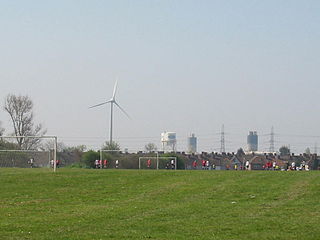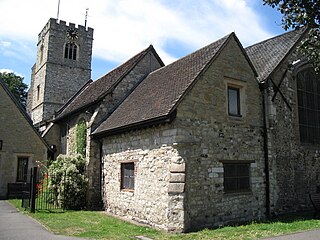
Jenkins was a manor under the overlordship of Barking manor. It was also known as 'Dagenham' manor, 'Dagenhams' and 'Dagenham Place' throughout the centuries. Today, the once open area has been consumed by suburbia.

Jenkins was a manor under the overlordship of Barking manor. It was also known as 'Dagenham' manor, 'Dagenhams' and 'Dagenham Place' throughout the centuries. Today, the once open area has been consumed by suburbia.
It was originally property of the Abbey of Barking, and was granted status of a freehold. This meant throughout time it was put for lease and indeed some manorial Lords did also lease nearby tenements. As such the estate at its largest spread as far as Dagenham village and it was found in some historical records to have stretched as far as East Hall. The original estate was located in present-day Mayesbrook Park in the London Borough of Barking & Dagenham, north of where Eastbury manor house stands today. Eastbury is a popular tourist attraction. [1]
Records from 1540 suggest that, at an ancient and unknown time, Barking Abbey had allowed the holding of Jenkins to a family recorded as Fitz-stephen, at a rent of 4 shillings and 4 pence. [2] In 1273 the manor of Jenkins was recorded as being held by Emery de Bezill, for a rent of 8 shillings 8 pence and a suit-court.
The Bishop of Winchester was leased Jenkins by Robert Osborne in 1448 for a rent of £13 6 shillings 8 pence. Osborne was purported to have assaulted the Abbess in 1450 over a disagreement regarding his access rights to a tenement he held in the Abbey grounds. Records show that in 1456 the manor was owned by the Abbey and was leased to a T. Plomer for a rent of 31 shillings 2 pence.
Records show that in 1479-80 Jenkins was purchased by a H. Brown and H. Wodecock. They sold Jenkins to a H. Brice, who held the neighbouring manor of Mal-maynes, further down the Mayes Brook towards the marshes. His son received the manor, but he was a child and died without heirs of his own. It then passed to his sister who married the Master of the Mint to Henry VIII, Robert Amadas. In 1555, the Jenkins estate belonged to Frances and Martin Bowes.
In 1567-68 the manor was conveyed to Henry Fanshawe who died later that year. His nephew then received the manor dying in 1601. The manor passed to his wife, but reverted to the Crown in 1628 and it was conveyed to Sir Thomas Fanshawe, their son. Documents describe the house of the time as a large gabled building which included a chapel with a window of stained glass containing an image of a woman suspected to be a depiction of the Abbess. A farmhouse stood on the original manor house site until 1937 when what was then called Jenkins farm was torn down for development of the expanding suburbs of London.
By tradition, a court baron and a court leet were held annually at Barking in April and a manorial court at Ilford in October. [3] The Lord of the Manor is no longer duty bound to hold these events as technically there are no people working the land for the manor; the manorial lands have now been consumed by the London Borough of Barking & Dagenham. However the title holder, Benjamin Harvey, Esq. retains the right to hold manorial courts at will.

Manorialism, also known as seigneurialism, the manor system or manorial system, was the method of land ownership in parts of Europe, notably France and later England, during the Middle Ages. Its defining features included a large, sometimes fortified manor house in which the lord of the manor and his dependants lived and administered a rural estate, and a population of labourers or serfs who worked the surrounding land to support themselves and the lord. These labourers fulfilled their obligations with labour time or in-kind produce at first, and later by cash payment as commercial activity increased. Manorialism was part of the feudal system.

Becontree or is an area of approximately 4 square miles (10 km2) in the London Borough of Barking and Dagenham. It is located 11 miles (17.7 km) east-northeast of Charing Cross and was constructed in the interwar period as the largest public housing estate in the world. The Housing Act 1919 permitted the London County Council to build housing outside the County of London and Becontree was constructed between 1921 and 1935 to cottage estate principles in the parishes of Barking, Dagenham and Ilford, then in the administrative and ceremonial county of Essex. The official completion of the estate was celebrated in 1935, by which time the estate had a population of around 100,000 people in 26,000 homes.

The London Borough of Barking and Dagenham is a London borough in East London. It lies around 9 miles (14.4 km) east of Central London. The borough was created in 1965 as the London Borough of Barking; the name was changed in 1980. It is an Outer London borough and the south is within the London Riverside section of the Thames Gateway; an area designated as a national priority for urban regeneration. At the 2011 census it had a population of 187,000. The borough's three main towns are Barking, Chadwell Heath and Dagenham. The local authority is the Barking and Dagenham London Borough Council. Barking and Dagenham was one of six London boroughs to host the 2012 Summer Olympics.

Dagenham is a town in East London, England, within the London Borough of Barking and Dagenham. Dagenham is centred 11.5 miles (18.5 km) east of Charing Cross.

Barking is a riverside town in East London, England, within the London Borough of Barking and Dagenham. It is 9.3 miles (15 km) east of Charing Cross. The total population of Barking was 59,068 at the 2011 census. In addition to an extensive and fairly low-density residential area, the town centre forms a large retail and commercial district, currently a focus for regeneration. The former industrial lands to the south are being redeveloped as Barking Riverside.

Abbess Roding is a village and former civil parish, now in the parish of Abbess, Beauchamp and Berners Roding and the Epping Forest District of Essex, England. The village is included in the eight hamlets and villages called The Rodings. It is in west Essex, 5 miles (8 km) north from Chipping Ongar, and 9 miles (14 km) west from the county town of Chelmsford. In 1931 the parish had a population of 169.
The King's Remembrancer is an ancient judicial post in the legal system of England and Wales. Since the Lord Chancellor no longer sits as a judge, the Remembrancer is the oldest judicial position in continual existence. The post was created in 1154 by King Henry II as the chief official in the Exchequer Court, whose purpose was "to put the Lord Treasurer and the Barons of Court in remembrance of such things as were to be called upon and dealt with for the benefit of the Crown", a primary duty being to keep records of the taxes, paid and unpaid.

Eastbury Manor House is a Grade I listed building situated in the London Borough of Barking and Dagenham in Greater London, England. It dates to the Elizabethan period, although the land on which it was built was formerly part of the demesne of Barking Abbey. The house is owned by the National Trust but has been managed since the 1930s by the London Borough of Barking and Dagenham and its predecessors. It is open to the public for 10 months of every year.

Weston Green is a small suburban village and a ward in the Elmbridge borough of Surrey. This area was, until 1901, a part of Thames Ditton with which it remains contiguous and associated. Weston Green is also contiguous with Esher, which provides the village's closest railway station. The village forms a rough triangle of land along the west side of the midsection of the Hampton Court Branch Line next to Thames Ditton railway station and down to Esher railway station, with the split between the two being the part dual-carriageway, the A309.

Barking Abbey is a former royal monastery located in Barking, in the London Borough of Barking and Dagenham. It has been described as having been "one of the most important nunneries in the country".

Valence House Museum is the only surviving of the five manor houses of Dagenham. The timber-framed museum building, partially surrounded by a moat, is situated in Valence Park off Becontree Avenue, in the London Borough of Barking and Dagenham, London, England. The building has been used as a manor house, a family home, a town hall, the headquarters of the library service and now houses a museum.
Eastbury may refer to:
Whorwellsdown was a hundred of the English county of Wiltshire, lying in the west of the county to the south of the towns of Bradford on Avon and Melksham and to the north and east of Westbury. An arm of the hundred reached several miles southwards into Salisbury Plain, with a detached portion, a tithing of Tilshead, lying high on the Plain about five miles east of the southern arm of the rest of the hundred. At its western end, it reached as far as the Somerset county boundary.

William Fanshawe was an English politician who sat in the House of Commons between 1614 and 1625.

Thomas Fanshawe (1533–1601) was a Member of the English Parliament during the reign of Queen Elizabeth I. He also held the civil service post of Queen's remembrancer of the exchequer.

Mayesbrook Park is a 43 hectare public park in Dagenham in the London Borough of Barking and Dagenham. It is owned and managed by the borough council. The southern end, which is mainly a large lake, is a Local Nature Reserve. The area covered by the park was once part of the historic Manor of Jenkins, seat of the Fanshawe family. For reasons which remain obscure, the park is sometimes nicknamed "Matchstick Island".
Parsloes Manor was a manor house in what is now known as Parsloes Park in Dagenham in the London Borough of Barking and Dagenham. In 1585, it was described as containing 10 messuages, a cottage, 10 gardens, 2 orchards, 100 acres of arable land, 20 acres of meadow, 50 of pasture 30 of wood and 40 rent.

Sir Thomas Fanshawe (1628–1705) was an English politician.

Marks was a manor house located near Marks Gate at the northern tip of the London Borough of Barking and Dagenham in London, England, the house standing on what is now Warren Hall Farm, about two miles west of Romford. The name Marks is believed to have been derived from the de Merk family who built the original manor in the 14th century. The manor house was demolished in 1808.

St Margaret's Church or the Church of St Margaret of Antioch is a Church of England parish church in Barking, East London. The church is a Grade I listed building, on a site dating back to the 13th century, within the grounds of the Roman Catholic Barking Abbey, the ruins of a former royal monastery that was originally established in the 7th century. The building is dedicated to Margaret the Virgin, also known as Margaret of Antioch.